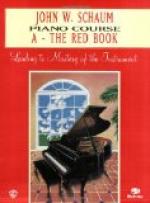“When a new theme enters you must make it plain to the listener; all the features of the new theme, the new figure, must be plastically brought out.
“Brilliancy does not depend on velocity but on clarity. What is not clear cannot scintillate nor sparkle. Make use of your strongest fingers in brilliant passages, leaving out the fourth when possible. A scale to be brilliant and powerful must not be too rapid. Every note must be round and full and not too legato—rather a mezzo legato—so that single tones, played hands together, shall sound like octaves. One of the most difficult things in rhythm, is to play passages where two notes alternate with triplets. Scales may be practised in this way alternating three notes with two.
“We must make things sound well—agreeably, in a way to be admired. A seemingly discordant passage can be made to sound well by ingeniously seeking out the best that is in it and holding that up in the most favorable light. Practise dissonant chords until they please the ear in spite of their sharpness. Think of the instruments of the orchestra and their different qualities of tone, and try to imitate them on the piano. Think of every octave on the piano as having a different color; then shade and color your playing. (Also bitte coloriren)!”
If Buelow’s musical trinity, Bach, Beethoven, and Brahms, had a fourth divinity added, it would surely have been Liszt. The first day’s program contained chiefly works by the Hungarian master; among them Au bord d’une Source, Scherzo and March, and the Ballades. The player who rendered the Scherzo was advised to practise octaves with light, flexible wrist; the Kullak Octave School was recommended, especially the third book; the other books could be read through, practising whatever seemed difficult and passing over what was easy. Of the Ballades the first was termed more popular, the second finer and more earnest—though neither makes very much noise.
The Annees de Pelerinage received much attention. Among the pieces played were, Les Cloches, Chasse Neige, Eclogue, Cloches de Geneva, Eroica, Feux Follets and Ma_zeppa_. Also the big Polonaise in E, the two Etudes, Waldesrauschen and Gnomenreigen; the Mazourka, Valse Impromptu, and the first Etude, of which last he remarked: “You can all play this; thirty years have passed since it was composed and people are only just finding out how fine it is. Such is the case with many of Liszt’s works. We wonder how they ever could have been considered unmusical. Yet the way some people play Liszt the hearer is forced to exclaim, ’What an unmusical fellow Liszt was, to be sure, to write like that!’
“Exactness in everything is of the greatest importance,” he was fond of saying. “We must make the piano speak. As in speaking we use a separate movement of the lips for each word, so in certain kinds of melody playing, the hand is taken up after each note. Then, too, we cannot make the piano speak without very careful use of the pedals.”




